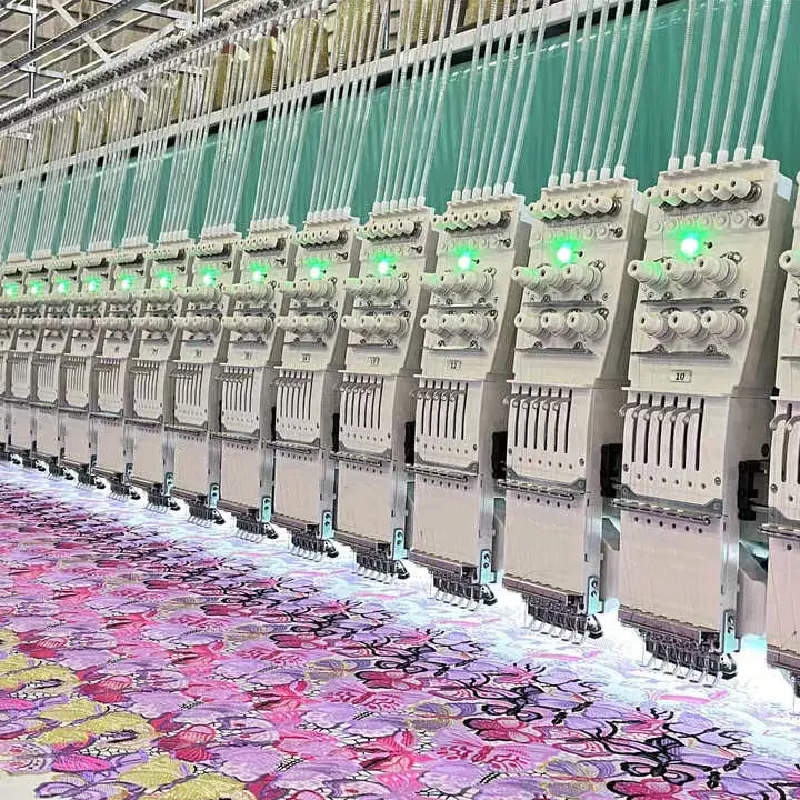10 月 . 19, 2024 02:09 Back to list
Multi-Head Embroidery Machine Manufacturing for Enhanced Textile Production Efficiency
The Evolution and Impact of Multi-Head Embroidery Machines in the Textile Industry
Embroidery has long been a revered art form, transforming fabrics into visually stunning creations through intricate stitching. As technology has progressed, so too has the way embroideries are created. One of the most significant advancements in this field is the introduction of multi-head embroidery machines. These machines, designed to enhance productivity and efficiency, have revolutionized the textile industry.
A multi-head embroidery machine, as the name suggests, is equipped with multiple sewing heads that allow it to embroider several pieces of fabric simultaneously. This capability significantly reduces production time compared to single-head machines, making it an essential tool for factories producing large volumes of embroidered items. Whether it’s for customizing uniforms, crafting intricate promotional merchandise, or producing delicate apparel, these machines have become invaluable in meeting the demands of various markets.
The emergence of multi-head embroidery machines can be traced back to the late 20th century when automation started to take a firm grip on manufacturing processes. Initially, embroidery was a labor-intensive craft, requiring skilled artisans to operate individual sewing machines for each piece. This approach was not only time-consuming but also limited the scale of production. The invention of multi-head machines brought a paradigm shift that allowed factories to scale operations efficiently.
In a typical multi-head setup, the machine can feature anywhere from two to 12 or more heads, depending on the model. This versatility means that businesses can choose the right machine based on their production needs. For instance, a small operation may opt for a two-head machine while larger firms might invest in machines with six or more heads to maximize their output. This scalability is particularly advantageous in an industry where demand can fluctuate.
One of the primary advantages of multi-head embroidery machines is their ability to maintain quality and consistency across all embroidered items. Each head works simultaneously on the same design, ensuring that every piece meets the same high standards. This uniformity is essential for brands that rely on their reputation for quality in order to maintain customer loyalty.
embroidery machine multi head factory

Moreover, advancements in technology have introduced features that enhance the capabilities of multi-head machines even further. Modern embroidery machines are often equipped with computerized systems that enable intricate designs to be programmed with ease. This means that businesses can produce customized products quickly, catering to the unique requirements of clients without sacrificing quality. With user-friendly interfaces, operators can also manipulate designs, adjust tensions, and monitor progress, making the entire process more streamlined.
In addition to efficiency and quality, multi-head embroidery machines also contribute to significant cost savings. By being able to produce more items in less time, businesses can lower their labor costs and increase profit margins. Furthermore, the ability to take on larger orders and meet tight deadlines makes firms equipped with these machines more competitive in the marketplace.
Despite their advantages, investing in multi-head embroidery machines requires careful consideration. The initial costs can be substantial, and maintenance is essential to keep the machines running smoothly. However, for many businesses in the textile industry, the benefits outweigh the drawbacks, particularly when it comes to scaling operations and meeting customer demands.
As we look towards the future, it is likely that technology will continue to advance, bringing even more innovations to the field of embroidery. Automation, artificial intelligence, and improved materials may further enhance the capabilities of multi-head machines. For factories still relying on traditional methods, the shift to modern multi-head embroidery machines presents an opportunity not just for growth, but for survival in a competitive industry.
In conclusion, multi-head embroidery machines represent a significant leap forward in the evolution of textile production. They combine efficiency, quality, and customization to meet the challenges of modern manufacturing. As businesses continue to adopt these technologies, the landscape of embroidery will undoubtedly keep evolving, making it an exciting time for both producers and consumers alike. The future of embroidery is bright, and multi-head machines are at the forefront of this transformation.
-
Professional Embroidery Machines High-Speed Industrial Solutions & Custom Designs
NewsMay.30,2025
-
Premium 2-Head Embroidery Machines Reliable Manufacturers & Suppliers
NewsMay.30,2025
-
12 Head Embroidery Machines High-Speed & Precision Stitching
NewsMay.30,2025
-
Premium Tshirt Embroidery Machines High-Speed & Precision Stitching
NewsMay.29,2025
-
6 Head Embroidery Machines High-Speed Multi-Head Designs & Suppliers
NewsMay.29,2025
-
Commercial Automatic 2 Heads Embroidery Machine Caps and shirts 12 15 Needles Two Heads Computerized Embroidery Machine
NewsMar.07,2025

Copyright © 2025 Xingtai Pufa Trading Co., Ltd All Rights Reserved. Sitemap | Privacy Policy
